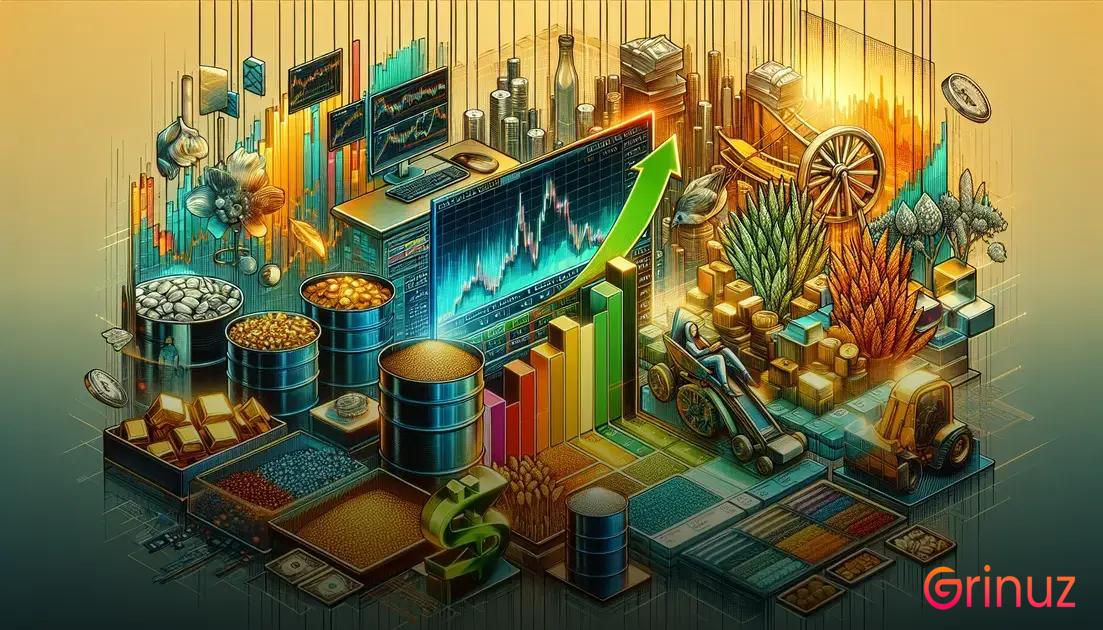Commodities trading is a dynamic and lucrative field, offering opportunities for substantial profits. Whether you’re a seasoned investor or a curious beginner, understanding the fundamentals and strategies of commodities trading is crucial. This blog post will explore key aspects like market trends, strategies, and how to start.
What is commodities trading?
Commodities trading involves buying and selling raw materials like gold, oil, grains, and metals. Traders aim to profit from price fluctuations in these physical assets. There are key markets including futures exchanges where standardized contracts are traded, and spot markets for immediate delivery.
Traders can use various strategies such as hedging and speculation. Hedging protects against price risks by securing a fixed price for future transactions. Speculation aims to capitalize on market movements for profit.
Market trends play a vital role. Traders must be adept at analyzing supply and demand factors, geopolitical events, and seasonal patterns. Understanding these elements can enhance decision-making and potentially lead to more profitable outcomes.
Top strategies for successful commodities trading

Diversify your portfolio by investing in a mix of commodities, such as oil, gold, and agricultural products. This helps to mitigate risk as different commodities react differently to market changes.
Stay informed
Keep up with global events and market news that can impact commodity prices. A well-informed trader can make timely decisions and seize profitable opportunities.
Use technical analysis
Leverage charts and historical data to predict future price movements. Look for patterns and trends that indicate potential highs and lows.
Develop a solid risk management strategy. Set stop-loss orders to minimize potential losses and protect your investments. Pay attention to leverage; excessive use can lead to significant losses.
Stay patient and disciplined
Commodities trading is not a get-rich-quick scheme. Success requires patience, discipline, and a long-term perspective.
Understanding market trends in commodities
Market trends play a crucial role in commodities trading. Understanding these trends can be the difference between profitable trades and significant losses. Traders need to keep an eye on several factors that influence market trends.
Supply and Demand: The most fundamental factor affecting market trends in commodities is supply and demand. When demand for a commodity exceeds its supply, prices tend to rise. Conversely, when supply exceeds demand, prices usually fall.
Economic Indicators: Economic indicators, such as GDP growth, unemployment rates, and inflation, also impact commodity prices. A booming economy typically increases demand for commodities, while a sluggish economy can decrease demand.
Geopolitical Events: Geopolitical events, including wars, trade disputes, and political instability, can significantly disrupt commodity markets. These events can cause sudden and unpredictable changes in supply, demand, and prices.
Seasonal Trends: Many commodities, especially agricultural products, exhibit seasonal trends. For example, the prices of crops such as wheat and corn may fluctuate based on planting and harvest cycles.
Technological Advances: Innovations in technology can drive market trends by changing how commodities are produced, processed, or consumed. Technological changes can create new opportunities or disrupt existing supply chains.
Market Sentiment: Trader sentiment, influenced by news, trends, and market analysis, plays a substantial role in commodity prices. Positive sentiment can drive prices up, whereas negative sentiment can lead to declines.
By comprehensively understanding these influencers, traders can make more informed decisions, align their strategies effectively, and potentially maximize their profits in the commodities market.
Risks and rewards in commodities trading

The commodities market offers significant opportunities for profit, but it also comes with its share of risks. Understanding these risks and rewards is crucial for anyone looking to succeed in commodities trading.
Volatility: One of the primary risks in commodities trading is market volatility. Prices can fluctuate dramatically due to factors such as geopolitical events, weather conditions, and changes in supply and demand. This can lead to potential losses if not managed properly. However, this same volatility can also provide opportunities for significant gains.
Leverage: Commodities trading often involves using leverage, which means traders need only a small amount of capital to control a large position. While leverage can amplify profits, it can also magnify losses, making it a double-edged sword.
Market Knowledge: Successful commodities traders typically have a deep understanding of the markets they are trading in. They keep up with news and trends that can impact commodity prices. A lack of market knowledge can lead to ill-informed trades and unnecessary risks.
On the other hand, rewards in commodities trading are equally compelling. High leverage can translate small price movements into substantial profits. Experienced traders who are well-versed in market trends can capitalize on price swings. Additionally, commodities can serve as a hedge against inflation and currency devaluation.
For traders who put in the time and effort to understand the market intricacies, the potential rewards can make commodities trading a highly lucrative endeavor.
By weighing the risks and rewards, traders can make informed decisions that align with their investment goals and risk tolerance.
How to start with commodities trading today
Starting with commodities trading can seem daunting at first, but the process is straightforward and rewarding if done correctly. Here’s a step-by-step guide to help you begin:
Research and education
Before diving in, it’s crucial to educate yourself on how commodities markets operate. Read books, online articles, and attend seminars. Familiarize yourself with terms like futures, options, and spot markets.
Choose a brokerage
Find a reputable broker that offers commodities trading. Look for platforms with low fees, reliable customer service, and useful trading tools. Ensure they are registered with regulatory bodies like the Commodity Futures Trading Commission (CFTC).
Create a trading plan
A solid trading plan includes your financial goals, risk tolerance, and strategies. Decide on how much capital you’re willing to invest and set stop-loss limits to minimize potential losses.
Start with a demo account
Most brokers offer demo accounts. These allow you to practice trading with virtual money. This is a great way to gain experience without risking real capital.
Analyze the market
Use technical analysis and fundamental analysis to make informed trading decisions. Keep an eye on global news, economic reports, and market trends that could impact commodity prices.
Execute your first trade
When you feel prepared, start by trading small amounts. Monitor your trades closely and learn from both your successes and mistakes.
By following these steps and remaining diligent, you can gradually build your expertise and start making profits in commodities trading.





